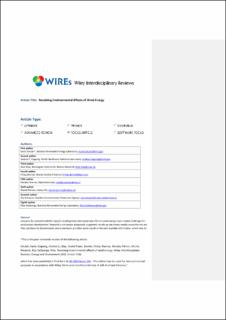Resolving environmental effects of wind energy
| dc.contributor.author | Sinclair, Karin | |
| dc.contributor.author | Copping, Andrea E. | |
| dc.contributor.author | May, Roelof Frans | |
| dc.contributor.author | Bennet, Finlay | |
| dc.contributor.author | Warnas, Marijke | |
| dc.contributor.author | Perron, Muriel | |
| dc.contributor.author | Elmqvist, Åsa | |
| dc.contributor.author | DeGeorge, Elise | |
| dc.date.accessioned | 2023-08-21T12:35:43Z | |
| dc.date.available | 2023-08-21T12:35:43Z | |
| dc.date.created | 2018-06-22T13:56:21Z | |
| dc.date.issued | 2018 | |
| dc.identifier.issn | 2041-840X | |
| dc.identifier.uri | https://hdl.handle.net/11250/3085088 | |
| dc.description.abstract | Concerns for potential wildlife impacts resulting from land-based and offshore wind energy have created challenges for wind project development. Research is not always adequately supported, results are neither always readily accessible nor are they satisfactorily disseminated, and so decisions are often made based on the best available information, which may be missing key findings. The potential for high impacts to avian and bat species and marine mammals have been used by wind project opponents to stop, downsize, or severely delay project development. The global nature of the wind industry—combined with the understanding that many affected species cross-national boundaries, and in many cases migrate between continents—also points to the need to collaborate on an international level. The International Energy Agency (IEA) Wind Technology Collaborative Programs facilitates coordination on key research issues. IEA Wind Task 34— WREN: Working Together to Resolve Environmental Effects of Wind Energy–is a collaborative forum to share lessons gained from field research and modeling, including management methods, wildlife monitoring methods, best practices, study results, and successful approaches to mitigating impacts and addressing the cumulative effects of wind energy on wildlife. WREN develops products such as white papers, fact sheets, and short science summaries, and is involved in a number of activities including hosting a webinar series and outreach and information dissemination through participation in meetings, workshops, and conferences to increase and expand the knowledge base pertaining to wildlife challenges at wind energy facilities. This information is available on WREN Hub, hosted on the Tethys website. adaptive management, cumulative impacts, dissemination, environmental effects, environmental trade-offs, population impacts, risk estimation, Tethys, wind energy | en_US |
| dc.description.abstract | Resolving environmental effects of wind energy | en_US |
| dc.language.iso | eng | en_US |
| dc.rights | Navngivelse 4.0 Internasjonal | * |
| dc.rights.uri | http://creativecommons.org/licenses/by/4.0/deed.no | * |
| dc.subject | adaptive management | en_US |
| dc.subject | windenergy | en_US |
| dc.subject | cumulative impacts | en_US |
| dc.subject | dissemination | en_US |
| dc.subject | environmental effects | en_US |
| dc.subject | environmental trade-offs | en_US |
| dc.subject | population impacts | en_US |
| dc.subject | risk estimation | en_US |
| dc.subject | Tethys | en_US |
| dc.title | Resolving environmental effects of wind energy | en_US |
| dc.type | Peer reviewed | en_US |
| dc.type | Journal article | en_US |
| dc.description.version | acceptedVersion | en_US |
| dc.rights.holder | © 2018 The Authors | en_US |
| dc.subject.nsi | VDP::Matematikk og naturvitenskap: 400 | en_US |
| dc.subject.nsi | VDP::Mathematics and natural scienses: 400 | en_US |
| dc.source.pagenumber | 10 | en_US |
| dc.source.volume | 7 | en_US |
| dc.source.journal | Wiley Interdisciplinary Reviews: Energy and Environment | en_US |
| dc.source.issue | 4 | en_US |
| dc.identifier.doi | 10.1002/wene.291 | |
| dc.identifier.cristin | 1593284 | |
| dc.relation.project | Andre: U.S. Department of Energy (DOE) No. DE-AC36-08GO28308 | en_US |
| dc.source.articlenumber | e291 | en_US |
| cristin.unitcode | 7511,2,0,0 | |
| cristin.unitname | Avdeling for terrestrisk økologi | |
| cristin.ispublished | true | |
| cristin.fulltext | original | |
| cristin.fulltext | postprint | |
| cristin.qualitycode | 1 |
Tilhørende fil(er)
Denne innførselen finnes i følgende samling(er)
-
Publikasjoner fra CRIStin - NINA [2364]
-
Scientific publications [1392]
Vitenskapelige artikler, kapitler og monografier i Open Access.

